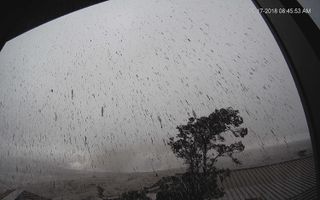Kilauea Spews Boulders in 5-Mile-High Eruption

An explosion at Kilauea volcano's summit spawned chunky boulders and a tremendous volcanic cloud that reached as high as commercial airplanes fly — about 30,000 feet (5.6 miles, or 9.1 kilometers) above sea level — early this morning (May 17) local time.
The explosion began as the volcano spewed out boulders hundreds of feet into the air at 4:15 a.m. Hawaii Standard Time, according to the U.S. Geological Survey (USGS). The earth-shattering event happened at the Overlook Vent, which holds a lava lake known as Halema'uma'u. On May 10, geologists with the Hawaiian Volcano Observatory (HVO) said that as Halema'uma'u drained further, there was a risk it could intersect with the water table underground, and heat that groundwater. If the crater's conduit became plugged by infalling boulders, the trapped steam could erupt dramatically, spewing boulders.
The new explosion sent Kilauea into code red, the highest-level warning for the volcano on Hawaii's Big Island, according to the HVO. [Photos: Fiery Lava from Kilauea Volcano Erupts on Hawaii's Big Island]
The miles-high ashy plume is drifting northeast, and it isn't a loner. The summit continues to emit plumes, some as high as 12,000 feet (2.2 miles, or 3.6 km) above sea level, the HVO said, adding that "at any time, activity may again become more explosive, increasing the intensity of ash production and producing ballistic projectiles near the vent."
An animated GIF the USGS tweeted out shows how far the ash cloud might travel.
USGS scientists use Ash3D computer simulations to show how far ash might travel and how much ash might fall to the ground. This graphic shows today's simulation (May 17) for the explosive eruption at Kīlauea’s summit. https://t.co/Ds1pWnFRVw pic.twitter.com/hGCoTBon1X
— USGS Volcanoes
Sign up for the Live Science daily newsletter now
Get the world’s most fascinating discoveries delivered straight to your inbox.
The National Weather Service has issued an ashfall advisory until 12 p.m. HST, the Hawaii County Civil Defense reported. Due to elevated sulfur dioxide levels in the area, local schools are also closed, the Hawaii County Civil Defense said.
The explosion is part of the heightened geologic activity around Kilauea that began in mid-March. You can find more of Live Science's coverage here.
Original article on Live Science.

Laura is the archaeology and Life's Little Mysteries editor at Live Science. She also reports on general science, including paleontology. Her work has appeared in The New York Times, Scholastic, Popular Science and Spectrum, a site on autism research. She has won multiple awards from the Society of Professional Journalists and the Washington Newspaper Publishers Association for her reporting at a weekly newspaper near Seattle. Laura holds a bachelor's degree in English literature and psychology from Washington University in St. Louis and a master's degree in science writing from NYU.
Most Popular

